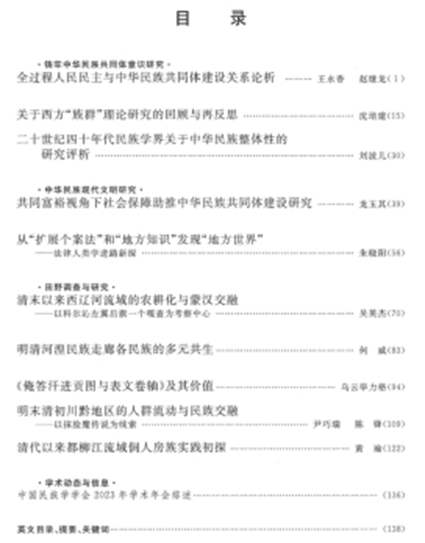Recently, Prof. Wuyun Bilige, Dean of the Institute of Advanced Studies of Ethnic Classics at our university, published his research results on Altan Khan Tribute Map and Memorial Scroll and Its Value and Prof. Wu Yingjie from the School of Ethnology and Sociology published his research results on "Farming and Mongolian and Han Integration in the West Liaohe River Basin Since the Late Qing Dynasty: Taking a Gacha in the Left Banner of Horqin as the investigation center " in "Ethnic Studies" (Issue 2, 2024).
Ethnic Studies is the highest-level journal in the field of ethnology research in China. It is also the top journal of the Chinese humanities and social sciences journal AMI, the Chinese Social Sciences Citation Index (CSSCI), the core journal of Peking University, and the journal funded by the Social Science Fund.



WuYun Bilige is the Dean, Prof., Doctor of Philosophy, and Doctoral Supervisor of the Institute of Advanced Studies in Ethnic Classics at Inner Mongolia University. He is a specially appointed Prof. of Changjiang Scholars by the Ministry of Education, a member of the Teaching Guidance Committee for History in Higher Education Institutions under the Ministry of Education, Vice President of the Chinese Society of Ethnic History, Vice President of the Chinese Society of Mongolian Studies, Editor in Chief of the International Society of Mongolian Studies journal Quaestiones Mongolorum Disputatae (Mongolian Studies Issues and Controversies), and Editor in Chief of the Hungarian Mongolian Studies journal Oyirad Studies.
Wu Yingjie graduated from Xiamen University in 2016 with a Doctor of Law degree. He is a high-level talent introduced by our university in 2016 and has published multiple papers in journals such as Cultural Heritage, Journal of Yunnan University for Nationalities (Philosophy and Social Sciences Sector), and Southwest Frontier Ethnic Studies. He has also led one provincial-level project.
Wuyun Bilige's Paper: Altan Khan Tribute Map and Memorial Scroll and Its Value Content Introduction:
The Altan Khan Tribute Map and Memorial Scroll collected by the Institute of Oriental Literature of the Russian Academy of Sciences is a 9-and-a-half-meter-long scroll. The scroll consists of two parts. The left half is a painting, painted in color on silk using the techniques of Chinese landscape painting. The content depicts the scene of the tribute envoy caravan of Mongolian leaders such as Altan Khan departing from Hohhot today and arriving at the Forbidden City in Beijing; The right half is a memorial presented by Altan Khan, and others to Emperor Wanli of the Ming Dynasty. This article focuses on the examination of the content of the painting, pointing out its meaning and value. It is believed that it is an extremely vivid cultural relic and document that reflects the history of communication, exchange, and integration among various ethnic groups in China.
Wu Yingjie's paper: Farming and Mongolian Han Integration in the West Liaohe River Basin Since the Late Qing Dynasty: Taking a Gacha in the Left Banner of Horqin as the Investigation Center.
Content Introduction:
The paper is based on first-hand data and information collected through long-term field investigations, with Ulannarengacha, Horqin Left Banner, West Liaohe River Basin as the center, focusing on the formation of the common livelihood and lifestyle of the Mongolian and Han ethnic groups in the process of agricultural development since the end of the Qing Dynasty, as well as the specific situation of the mutual influence of Mongolian and Han cultures in this process. The West Liaohe River Basin, which connects North China and Northeast China, is a typical agricultural pastoral transitional zone and ethnic mixed area in northern China. Economic and cultural exchanges between ethnic groups are very close.
The article believes that the formation of local agricultural production and lifestyle has provided favorable external conditions for ethnic communication, exchange, and integration. With the continuous introduction of new species and the popularization of agricultural technology, the Mongolian and Han common livelihood has been formed and developed, and the cooperative relationship between village members has been further strengthened. New changes have also emerged in various aspects such as living environment, living patterns, modes of transportation, dietary habits, and lifestyle customs. The transformation of local production methods from animal husbandry to agriculture has promoted the development of the binding relationship between people and land, as well as the interdependence between villages and arable land. It has also facilitated the formation of a common livelihood and the convergence of lifestyles between Mongolia and China, highlighting the trend of mutual dependence and continuous integration between the two.

